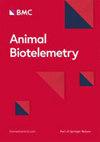一种抗噪声的动物自动无线电定位跟踪系统
IF 2.5
3区 环境科学与生态学
Q2 BIODIVERSITY CONSERVATION
引用次数: 0
摘要
农业越来越依赖传感器阵列的准确数据,本地化是畜牧业的一个新兴应用。基于地面的到达时间差(TDoA)无线电定位方法具有重量轻的优点,并且与依赖全球导航卫星系统(GNSS)的方法相比表现出更高的能效。这种方法可以使用小型原电池,而不是可充电电池,并且仍然可以实现多年部署。在本文中,我们提出了一种新的深度学习算法,该算法改编自一维U-Net,实现了卷积神经网络(CNN)模型,最初是为语义分割任务开发的。所提出的模型(ResUnet-1d)既将TDoA序列直接转换为位置,又减少了由多路径等源引入的位置误差。我们使用TDoA位置序列形式的模拟动物运动,结合TDoA误差的真实世界分布,对模型进行了评估。以不同的步长间隔模拟这些动物轨迹,以模拟潜在的TDoA传播间隔。我们将ResUnet-1d与卡尔曼滤波器进行比较,以评估我们的算法与更传统的降噪方法的性能。平均而言,对于具有标准偏差为50m的附加噪声的模拟轨道,所述方法能够将定位误差降低66.3%至73.6%。卡尔曼滤波器仅实现8.0%至22.5%的降低。对于具有较大附加噪声且标准偏差为100m的场景,所述方法能够将平均定位误差降低76.2%至81.9%。卡尔曼滤波器仅实现31.0%至39.1%的降低。结果表明,这种用于TDoA定位误差校正的新型1D CNN类U-Net编码器/解码器优于卡尔曼滤波器。在所有模拟实验处理中,它能够将平均定位误差降低到16到34m之间,而未校正的平均TDoA误差范围在55到188m之间。本文章由计算机程序翻译,如有差异,请以英文原文为准。
A noise robust automatic radiolocation animal tracking system
Agriculture is becoming increasingly reliant upon accurate data from sensor arrays, with localization an emerging application in the livestock industry. Ground-based time difference of arrival (TDoA) radio location methods have the advantage of being lightweight and exhibit higher energy efficiency than methods reliant upon Global Navigation Satellite Systems (GNSS). Such methods can employ small primary battery cells, rather than rechargeable cells, and still deliver a multi-year deployment. In this paper, we present a novel deep learning algorithm adapted from a one-dimensional U-Net implementing a convolutional neural network (CNN) model, originally developed for the task of semantic segmentation. The presented model ( ResUnet-1d ) both converts TDoA sequences directly to positions and reduces positional errors introduced by sources such as multipathing. We have evaluated the model using simulated animal movements in the form of TDoA position sequences in combination with real-world distributions of TDoA error. These animal tracks were simulated at various step intervals to mimic potential TDoA transmission intervals. We compare ResUnet-1d to a Kalman filter to evaluate the performance of our algorithm to a more traditional noise reduction approach. On average, for simulated tracks having added noise with a standard deviation of 50 m, the described approach was able to reduce localization error by between 66.3% and 73.6%. The Kalman filter only achieved a reduction of between 8.0% and 22.5%. For a scenario with larger added noise having a standard deviation of 100 m, the described approach was able to reduce average localization error by between 76.2% and 81.9%. The Kalman filter only achieved a reduction of between 31.0% and 39.1%. Results indicate that this novel 1D CNN U-Net like encoder/decoder for TDoA location error correction outperforms the Kalman filter. It is able to reduce average localization errors to between 16 and 34 m across all simulated experimental treatments while the uncorrected average TDoA error ranged from 55 to 188 m.
求助全文
通过发布文献求助,成功后即可免费获取论文全文。
去求助
来源期刊

Animal Biotelemetry
Agricultural and Biological Sciences-Animal Science and Zoology
CiteScore
4.20
自引率
11.10%
发文量
33
审稿时长
10 weeks
期刊介绍:
Animal Biotelemetry is an open access peer-reviewed journal that publishes the results of studies utilizing telemetric techniques (including biologgers) to understand physiological, behavioural, and ecological mechanisms in a broad range of environments (e.g. terrestrial, freshwater and marine) and taxa. The journal also welcomes descriptions and validations of newly developed tagging techniques and tracking technologies, as well as methods for analyzing telemetric data.
 求助内容:
求助内容: 应助结果提醒方式:
应助结果提醒方式:


